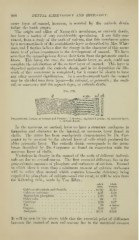Page 598 - My FlipBook
P. 598
;
608 DENTAL EMBRYOLOGY AND HISTOLOGY.
outer layer of enamel, however, is secreted by the cuticula dentis
before the tooth erupts.
The origin and office of Nasrayth's membrane, or cuticula dentis,
has been a matter of very considerable speculation. I am fully con-
vinced, from a study of the teeth of rodents, that this mem]>rane arises
by a metamorphosis of the ameloblastic layer as described by Mrs. Whit-
man, and I farther believe that the change in the character of this mem-
brane is of prime importance in the development of enamel. We have
seen that the enamel-prisms derive their form from the prismatic amelo-
blasts. This being the case, the ameloblastic layer, as such, could not
complete the calcification of the cortical layer of enamel. This layer is
deposited underneath the cuticula dentis, and in its deposition the life-
work of this membrane is com])leted ; for it cannot be shown to have
any other essential signification. In a newly-erupted tooth the enamel
may be divided into tliree layers—the internal, or prismatic ; the corti-
cal, or nacreous; and the organic layer, or cuticula dentis.
Diagrammatic Section of Eraniel and Dentine: '7, dentine; e7;i, enamel prisms; ?i/, nacreous layer
(7, cuticula dentis.
In the nacreous, or cortical, layer we have a structure analogous in
formation and character to the internal, or nacreous, layer found in
shells. The latter has been conclusively demonstrated by Dr. Car-
penter to be secreted by the altered layer of cells which produced the
older prismatic layer. The cuticula dentis corresponds to the mem-
brane described by Dr. Carpenter as found in connection with the
nacreous layer of shells.
Variations in density in the enamel of the teeth of different individ-
uals are due to several causes. The first essential diflFerence lies in the
proportionate amounts of phosphate and carbonate of calcium. Enamel
in which there is more than a minimum amount of calcium carbonate
will be softer than enamel which contains less—the deficiency being
sup])licd by phospliate of calcium—and vice versd, as will be seen from
the following table, made by Von Bibra :
Adult Adult
man. woman.
Calpinm phosphate and fluoride 89.82 81.83
Calcium carbonnte 437 g gg
Masncsiiini pliosphatc 1.34 2.55
Otlier salts 88 .97
Cartilage 3.39 5.97
Fat . 20 a trace.
Organic 3.59 5.97
Inorganic 96.41 94.03
It will be seen l)y the above table that the essential point of difference
between the enamel of man and woman lies in the contained amount
608 DENTAL EMBRYOLOGY AND HISTOLOGY.
outer layer of enamel, however, is secreted by the cuticula dentis
before the tooth erupts.
The origin and office of Nasrayth's membrane, or cuticula dentis,
has been a matter of very considerable speculation. I am fully con-
vinced, from a study of the teeth of rodents, that this mem]>rane arises
by a metamorphosis of the ameloblastic layer as described by Mrs. Whit-
man, and I farther believe that the change in the character of this mem-
brane is of prime importance in the development of enamel. We have
seen that the enamel-prisms derive their form from the prismatic amelo-
blasts. This being the case, the ameloblastic layer, as such, could not
complete the calcification of the cortical layer of enamel. This layer is
deposited underneath the cuticula dentis, and in its deposition the life-
work of this membrane is com])leted ; for it cannot be shown to have
any other essential signification. In a newly-erupted tooth the enamel
may be divided into tliree layers—the internal, or prismatic ; the corti-
cal, or nacreous; and the organic layer, or cuticula dentis.
Diagrammatic Section of Eraniel and Dentine: '7, dentine; e7;i, enamel prisms; ?i/, nacreous layer
(7, cuticula dentis.
In the nacreous, or cortical, layer we have a structure analogous in
formation and character to the internal, or nacreous, layer found in
shells. The latter has been conclusively demonstrated by Dr. Car-
penter to be secreted by the altered layer of cells which produced the
older prismatic layer. The cuticula dentis corresponds to the mem-
brane described by Dr. Carpenter as found in connection with the
nacreous layer of shells.
Variations in density in the enamel of the teeth of different individ-
uals are due to several causes. The first essential diflFerence lies in the
proportionate amounts of phosphate and carbonate of calcium. Enamel
in which there is more than a minimum amount of calcium carbonate
will be softer than enamel which contains less—the deficiency being
sup])licd by phospliate of calcium—and vice versd, as will be seen from
the following table, made by Von Bibra :
Adult Adult
man. woman.
Calpinm phosphate and fluoride 89.82 81.83
Calcium carbonnte 437 g gg
Masncsiiini pliosphatc 1.34 2.55
Otlier salts 88 .97
Cartilage 3.39 5.97
Fat . 20 a trace.
Organic 3.59 5.97
Inorganic 96.41 94.03
It will be seen l)y the above table that the essential point of difference
between the enamel of man and woman lies in the contained amount


